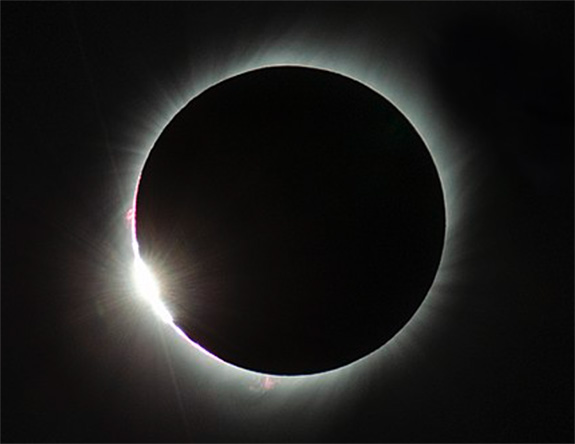
Dive Service Rescues 115-Year-Old Heirloom Wedding Ring From Texas Lake
A cherished 115-year-old wedding ring thought to be lost forever in a Texas lake has been miraculously recovered — thanks to the relentless efforts of
About 20,000 skygazers descended on the small resort town of Exmouth on Western Australia’s North West Cape last Thursday to experience a wondrous celestial phenomenon — a total solar eclipse that looked remarkably like a diamond ring.

The Diamond Ring Effect, which was first explained by Francis Baily in 1836, occurs when the Moon completely masks out the Sun during a solar eclipse. Due to the rugged lunar landscape, the black outline of the moon is not smooth. Tiny beads of sunlight can still shine through in some places and not in others as the moon slowly grazes past the sun.
These are called Baily’s Beads. When only one dazzling “bead” remains, momentarily, the view of the eclipse resembles a diamond ring. The ring’s glow is produced by the Sun’s corona remaining dimly visible around the lunar silhouette.
The Diamond Ring Effect can be seen in the instant just before the total solar eclipse and in the moment just after. In Australia, the Diamond Ring was visible for only a second or two, while the eclipse lasted about a minute.
NASA astronomer Henry Throop was one of the thousands cheering the daytime blackout, explaining to an NPR reporter that the experience was “mind blowing.”
“I feel so emotional, like I could cry,” added Fremantle, Australia, native Julie Copson.
Solar eclipses are the result of an uncanny mathematical coincidence. The Moon is 400 times smaller than the Sun, but is 400 times closer to the Earth. This results in two celestial discs that are virtually the same size visually.
On occasion, solar eclipses will occur when the Moon, in its elliptical orbit, is near its farthest point from Earth and appears slightly smaller than average. In that case, the halo of the Sun is more prominent and the Diamond Ring Effect doesn’t occur. Instead, we are treated to a “ring of fire” solar eclipse — also known as a “wedding band in the sky.”
Scientists described this type of eclipse as “annular,” a word derived from “annulus,” which means ring-like object.
While Exmouth (pop. 3,000) had been touted as the best place in Australia to see Thursday’s solar eclipse, the spectacular show was also visible in parts of Indonesia and East Timor.
The next total solar eclipse over North America will take place on April 8, 2024. The next annular eclipse over North America is set for October 14, 2023.
The image, above, was captured by NASA at an observatory in Chile in 2019. Thursday’s eclipse was live-streamed by NASA, but the videographer was not able to get a clear shot of the Diamond Ring Effect.
Credit: Image by NASA/Goddard/Rebecca Roth NASA Goddard Space Flight Center from Greenbelt, MD, USA, CC BY 2.0, via Wikimedia Commons.

A cherished 115-year-old wedding ring thought to be lost forever in a Texas lake has been miraculously recovered — thanks to the relentless efforts of

Welcome to Music Friday, when we spotlight songs that sparkle with references to jewelry, gemstones or precious metals. Today, we’re revisiting a luminous synthpop anthem

Last week’s Magnificent Jewels sale at Christie’s New York dazzled collectors and historians alike, thanks in large part to the headline-grabbing success of the “Mughal

Platinum is enjoying a powerful rally in 2025, recently topping $1,330 per ounce — a 10-year high and a 44% gain since the start of






Celebrate Your Everlasting Love with Elliott's Jewelers!
Mark another year of cherished memories with our breathtaking Anniversary Ring, exclusively at Elliott's Jewelers in Huntsville, TX.
This exquisite ring features five natural bezel-set pear-shaped diamonds, meticulously crafted in 14kt yellow gold. With a remarkable 1.19 carats total weight of dazzling diamonds, this piece is a true testament to enduring love and sophisticated style.
Imagine the sparkle on her hand, a symbol of your unique journey together. This isn't just a ring; it's a future heirloom, a radiant reminder of your commitment.
Ready to see this stunning anniversary ring in person? We invite you to schedule a private viewing at your convenience.
Click here to book your appointment: www.elliottsjewlers.com/book-an-appointment
#ElliottsJewelers #AnniversaryRing #DiamondRing #PearShapedDiamonds #YellowGold #HuntsvilleTX #FineJewelry #CelebrateLove #TimelessTreasure
#TimelessTreasures #timelesstreasuresfabrics ... See MoreSee Less
Shop Now
0 CommentsComment on Facebook
Make a Statement with This Dazzling Orange-Yellow Diamond Engagement Ring! 🧡💛
Imagine her reaction when you present this one-of-a-kind Ladies Fancy Orange-Yellow Diamond Engagement Ring from Elliott's Jewelers!
This stunning ring features a vibrant 1.05 carat Orange-Yellow Radiant Cut center diamond, with SI1 clarity, that radiates warmth and brilliance. Complementing this magnificent center stone are 0.20 total weight Trillion side diamonds, adding an exquisite touch of sparkle. All set in elegant 14k White Gold, this ring is truly a masterpiece.
It's more than just a ring; it's a symbol of your unique love story.
Ready to make her dreams come true? Visit Elliott's Jewelers in Huntsville, TX, to see this breathtaking ring in person! Make an appointment at www.elliottsjewelers.com/book-an-appointment/
#OrangeYellowDiamond #EngagementRing #FancyDiamond #RadiantCut #DiamondRing #UniqueEngagementRing #HuntsvilleJeweler #ElliottsJewelers #SayYes #SheWillLoveIt #14kWhiteGold
#14kwhitegold ... See MoreSee Less
0 CommentsComment on Facebook
🌟 Protect Your Precious Jewelry with Confidence! 🌟
Ensure your cherished pieces are safeguarded against life's surprises. With our comprehensive jewelry insurance, your items will be repaired or replaced to their original kind and quality, giving you peace of mind.
Ready for a professional appraisal? Experience our six-step process designed for your convenience and satisfaction, led by owner Elliott Herzlich. Discover how easy it is to protect your investment!
Learn more here: [Elliott's Appraisal Services](www.elliottsjewelers.com/appraisal-services/)
#JewelryInsurance #JewelryAppraisal #ElliottsJewelers #ProtectYourInvestment #LuxuryJewelry #JewelryCare ... See MoreSee Less
Act Now: Get It Insured
www.jewelersmutual.com
Dedicated Jewelry Insurance Wear your jewelry worry-free with insurance from Jewelers Mutual, trusted for over 110 years. CHECK YOUR RATE ReviewsWhat's CoveredCostHow It WorksFAQs What Types of Jewelr...0 CommentsComment on Facebook
We are taking appointments at www.elliottsjewelers.com/book-an-appointment/ . ... See MoreSee Less
2 CommentsComment on Facebook
The Heart of a Personal Jeweler -- Elliott's Jewelers, Huntsville, TX
Want to learn more about Elliott's Jewelers?
Check out our story in Voyage Houston magazine! voyagehouston.com/.../check-out-elliott-herzlichs...
At Elliott’s Jewelers, clients aren’t just customers—they’re relationships built for life. With a blend of old-world craftsmanship, new-world sensibility, and unwavering integrity, Elliott has crafted something rare in modern retail: a business that prioritizes people above all else.
To book a private consultation or learn more about Elliott’s Jewelers, visit www.elliottsjewelers.com. ... See MoreSee Less
Learn More
0 CommentsComment on Facebook
✨ Why Choose a Diamond from Elliott’s Jewelers? ✨
A natural diamond is more than a purchase; it’s a timeless symbol of your love story, your shared memories, and the beautiful future you envision together. 💍❤️
At Elliott’s Jewelers, we offer a personal touch that sets us apart. When you choose your diamond with us, you're not just buying a gem; you're creating an experience. Our trusted jewelers will be by your side, guiding you every step of the way, ensuring you find the perfect diamond that resonates with your unique love.
Don't leave one of life's most precious moments to chance. Embrace the luxury of personalized service and make a confident choice that reflects your heart.
💖 Schedule your private consultation today, and let Elliott help you discover the diamond that feels like it was made just for you.
👉 www.elliottsjewelers.com/book-an-appointment
See available diamonds here: www.elliottsjewelers.com/diamonds-with-grading-report/
#ElliottsJewelers #DiamondLove #EngagementRing #LoveStory #ForeverStartsHere #PersonalJeweler #TimelessBeauty ... See MoreSee Less
Shop Now
Elliott's Jewelers, Huntsville TX Favorite Jeweler
www.elliottsjewelers.com
I get to create beautiful, memorable and emotional jewelry for customers who become lifelong friends. Call me to learn more.0 CommentsComment on Facebook
### Discover the Art of Custom Engagement Rings at Elliott’s Jewelers. Learn more about this ring and others at
www.elliottsjewelers.com/shop
✨ The beauty of a custom engagement ring lies in the intricate details—and in the journey of collaborating with a personal jeweler who truly understands your lifestyle and values. At Elliott’s Jewelers, we dedicate ourselves to bringing your vision to life, crafting a ring that's uniquely yours. 💍Elliott's Jewelers only offers genuine, natural, mined diamonds
📞 Call Elliott's Jewelers today at (936) 661-5363 or book an appointment online—available 6 days a week! www.elliottsjewelers.com/book-an-appointment/
🛍️ Browse our stunning collections online: www.elliottsjewelers.com/shop/
#CustomJewelry #EngagementRing #ElliottsJewelers #JewelryDesign #Personalized #Craftsmanship #Love #Engagement #JewelryShopping #UniqueDesigns ... See MoreSee Less
Call Now
2 CommentsComment on Facebook
✨ Your Jewelry Has an Irreplaceable Story to Tell ✨
The jewelry you’ve inherited is more than just exquisite; it's a treasured chapter of your family's legacy, a timeless piece that can be passed down through generations.
Every ring, bracelet, and pendant embodies the love, memories, and milestones that have shaped your family's journey. When you choose Elliott’s Jewelers, you’re not only preserving jewelry—you’re honoring the deep-rooted connections that bind your family together.
At Elliott's, we provide a comprehensive range of services to restore and protect your beloved heirlooms, including:
💍 Ring resizing
💎 Stone replacement
🔩 Prong repair & retipping
🔗 Chain & clasp repairs
✨ Professional cleaning & polishing
🔄 Full restorations
🎨 Custom redesigns, honoring the original while crafting something uniquely new.
Every repair is conducted with the same love and attention that your family deserves. Together, we’ll breathe new life into your cherished pieces, allowing you to wear them with pride and continue their story for many more years to come.
📅 Schedule your repair appointment with Elliott today, and let’s celebrate your family’s extraordinary legacy! Schedule your appointment here at www.elliottsjewelers.com/book-an-appointment/ ... See MoreSee Less
Book Travel
0 CommentsComment on Facebook
## Celebrate Your Everlasting Love with a Natural Diamond Ring from Elliott's Jewelers
Special moments deserve a ring as meaningful as the love they represent. At Elliott's Jewelers, we believe your unique story deserves to be told through the timeless brilliance of a **natural, earth-mined diamond**. Each diamond, forged deep within the earth, carries a history as rich and profound as the love you share.
We're here for every "yes," every happy tear, and every milestone yet to come. Let us help you create a ring that beautifully encapsulates your love and memories for a lifetime. Our commitment to exceptional quality and personalized service ensures your journey with us is as special as the love you're celebrating.
**Ready to find the perfect symbol of your devotion?**
* **Call Elliott's Jewelers today at (936) 661-5363** to speak with one of our diamond experts.
* **Book your personal appointment online:** We're available 6 days a week to assist you! Visit our booking page here: www.elliottsjewelers.com/book-an-appointment/
* **Browse our exquisite collection online:** --- www.elliottsjewelers.com/diamonds-with-grading-report/
Let's create a ring that will be cherished for generations. ... See MoreSee Less
Learn More
0 CommentsComment on Facebook
✨ Your Jewelry Has an Irreplaceable Story to Tell ✨
The jewelry you’ve inherited is more than just exquisite; it's a treasured chapter of your family's legacy, a timeless piece that can be passed down through generations. Every ring, bracelet, and pendant embodies the love, memories, and milestones that have shaped your family's journey. When you choose Elliott’s Jewelers, you’re not only preserving jewelry—you’re honoring the deep-rooted connections that bind your family together.
At Elliott's, we provide a comprehensive range of services to restore and protect your beloved heirlooms, including:
💍 Ring resizing
💎 Stone replacement
🔩 Prong repair & retipping
🔗 Chain & clasp repairs
✨ Professional cleaning & polishing
🔄 Full restorations
🎨 Custom redesigns, honoring the original while crafting something uniquely new
Every repair is conducted with the same love and attention that your family deserves. Together, we’ll breathe new life into your cherished pieces, allowing you to wear them with pride and continue their story for many more years to come.
📅 Schedule your repair appointment with Elliott today, and let’s celebrate your family’s extraordinary legacy! Schedule your appointment here at www.elliottsjewelers.com/book-an-appointment/ ... See MoreSee Less
Book Travel
0 CommentsComment on Facebook
### Discover the Art of Custom Engagement Rings at Elliott’s Jewelers.
Learn more about the ring featured below: www.elliottsjewelers.com/product/14-kt-white-gold-radiant-cut-diamond-engagement-ring-with-2-21-c...
✨ The beauty of a custom engagement ring lies in the intricate details—and in the journey of collaborating with a personal jeweler who truly understands your lifestyle and values. At Elliott’s Jewelers, we dedicate ourselves to bringing your vision to life, crafting a ring that's uniquely yours. 💍Elliott's Jewelers only offers genuine, natural, mined diamonds
📞 Call Elliott's Jewelers today at (936) 661-5363 or book an appointment online—available 6 days a week! www.elliottsjewelers.com/book-an-appointment/
🛍️ Browse our stunning collections online: www.elliottsjewelers.com/shop/
#CustomJewelry #EngagementRing #ElliottsJewelers #JewelryDesign #Personalized #Craftsmanship #Love #Engagement #JewelryShopping #UniqueDesigns ... See MoreSee Less
Shop Now
Shop - Elliott's Jewelers
www.elliottsjewelers.com
Appointments available Tuesday through Saturday. Please schedule at www.elliottsjewelers.com/book-an-appointment/ or visit www.elliottsjewelers.com/shop ... See MoreSee Less4 CommentsComment on Facebook
Want to learn more about Elliott's Jewelers? Check out our story in Voyage Houston magazine! voyagehouston.com/interview/check-out-elliott-herzlichs-story
The Heart of a Personal Jeweler
At Elliott’s Jewelers, clients aren’t just customers—they’re relationships built for life. With a blend of old-world craftsmanship, new-world sensibility, and unwavering integrity, Elliott has crafted something rare in modern retail: a business that prioritizes people above all else.
To book a private consultation or learn more about Elliott’s Jewelers, visit www.elliottsjewelers.com. ... See MoreSee Less
Call Now
3 CommentsComment on Facebook